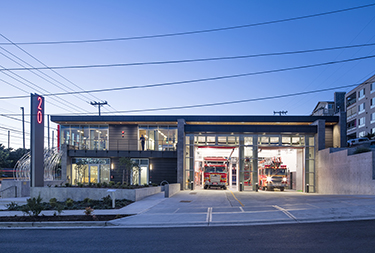|
Subscribe / Renew |
|
|
Contact Us |
|
| ► Subscribe to our Free Weekly Newsletter | |
| home | Welcome, sign in or click here to subscribe. | login |
Construction
| |
 |
November 5, 2015
Interbay fire station is one of the nation’s greenest
Schacht Aslani Architects

Aman
|
The new Fire Station 20 is located at the western base of Queen Anne Hill on the heavily trafficked 15th Avenue West and serves a rapidly growing Interbay neighborhood.
Given the highly visible site, the city of Seattle identified the project as an opportunity to create a civic presence for the Fire Department while setting a new high-performance design standard for its facilities.
The Fire Facilities and Emergency Response Levy passed in 2003 identified the then-55-year-old Station 20 as one of the smallest stations in the system, insufficient to meet the neighborhood’s needs.
The building was in poor condition and had reached the end of its useful building life, not meeting the emergency response operational requirements of the Seattle Fire Department or current earthquake safety standards.
In 2009, the Seattle City Council authorized the purchase of two vacant parcels and two small properties along the east side of 15th Avenue West, a major arterial that runs through the Interbay industrial zone connecting downtown with the Queen Anne and Ballard neighborhoods. Schacht Aslani Architects was selected to design the new, modern two-engine-bay station.
From 2010 to 2014, the station’s emergency response calls increased by nearly 13 percent. The design for the new station accounts for the rapidly growing Interbay community and considerable redevelopment within its service areas of Queen Anne and Magnolia.
Siting challenge
Fire Station 20 addresses a number of interrelated challenges: differentiating the building from its industrial and commercial neighbors, many with large garage doors; cutting through the steep topography to create a drive-through apparatus bay; creating privacy for the firefighters’ living quarters adjacent to the busy thoroughfare; and carrying out an ambitious sustainable design agenda.
A series of parallel concrete and masonry walls in the north-south direction retain the hillside, organize the site, contain green infrastructure, and provide lateral resistance for the building.
Steel-framed volumes that contain the program run over and between the masonry walls in the east-west direction. Their major openings are perpendicular to the walls and the street, maximizing daylight and views, reducing solar gain and shielding the living quarters from acoustic impacts.
Earning LEED platinum
The city of Seattle has utilized the U.S. Green Building Council’s LEED rating system for city-owned facilities since 2000. Over the years, the city has continually raised the bar for high-performance buildings, resulting in an increasing number of LEED gold-certified facilities.
For Fire Station 20, the city chose to exceed its own standards, and challenged the design team to create a building that met the criteria for LEED platinum certification. Through an ambitious sustainable design agenda, the project achieved 98 points and LEED platinum status, making it the highest-scoring fire station in the country.
The project also follows the guidelines set in the Architecture 2030 Challenge. The challenge is designed to significantly reduce carbon emissions and fossil fuel consumption, with long-term goals to have all new buildings be carbon-neutral. Ultimately the steps taken in the design for Fire Station 20 meet the 2015 targets for the Architecture 2030 Challenge.
Bioretention planters and green roofs contain plants, soil and gravel, which manage stormwater, cool the site, and integrate the masonry building walls with the hillside retaining walls. Native, drought-tolerant plants are used to buffer the station from the street and require very little water once established.
Energy-reduction strategies
The design team took an aggressive approach to energy conservation. The energy modeling of the station was completed by Hargis Engineers, simulating the building’s energy consumption throughout the design process. The final system selections were evaluated through a customized energy model to simulate the 30-year performance of the ground source heat pump, as well as standalone simulations of HVAC coils that directly utilize ground source water for cooling during swing seasons.
Heating and cooling is provided by a ground source water-to-water heat pump system. A flat-plate heat exchanger recovers energy from the relief air stream to the fresh outside air stream. The 35-kilovolt photovoltaic array on the roof provides 27 percent of the energy used by the station. LED fixtures, occupancy sensors and daylight harvesting further increase the electrical energy savings.
Energy performance in any fire station is a primary design challenge due to the demands of the apparatus bay and the nature of large bay doors that open frequently. To mitigate the heat loss that occurs during frequent crew deployment, the apparatus bay contains a radiant floor heating system, which, together with the thermal mass of the concrete walls and floor, allows the indoor temperature to rebound efficiently.
Meanwhile, the residential portion of the building is served by a central heat recovery air-handling unit with dedicated variable air volume units and temperature sensors that allow for individual zone control. The ground source water-to-water heat pump system provides an opportunity to create a variety of zones that support a firefighter’s daily routine of work, training and rest or sleep.
Fire Station 20 attempts to educate the community on how public buildings can employ sustainable strategies without sacrificing program space. Strategically located site signage invites the public on a self-guided tour of the station’s sustainable systems. A low-energy flip-dot sign along the 15th Avenue West arterial is connected to the building’s control system and displays real-time information on energy, water and carbon savings.
Operational since last December, Fire Station 20 serves as a symbol of the city’s commitment to improving the performance of its buildings while creating a civic structure that contributes to the character of its rapidly growing service area.
Eric Aman is a principal with Schacht Aslani Architects, with 20 years of experience in the planning and design of public sector facilities.
Other Stories:
- Will your fire station be open after the Big One hits?
- Here’s how we slashed one station’s energy use by 75 percent
- Fire Training centers today are more like the real world
- How to keep fire crews moving as the city grows



